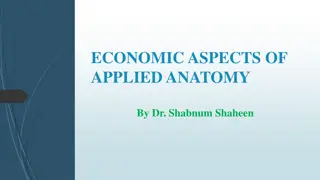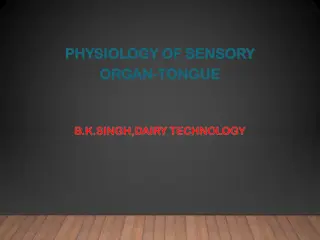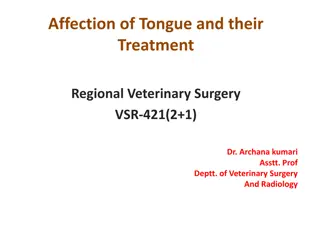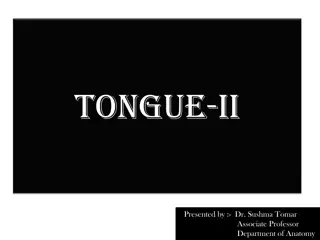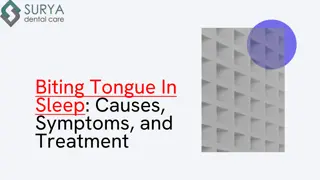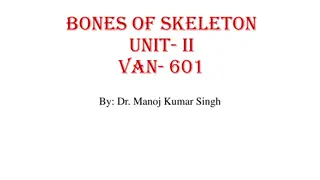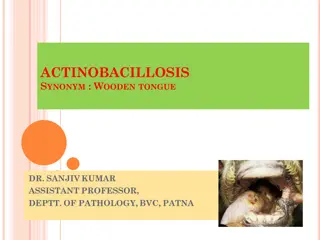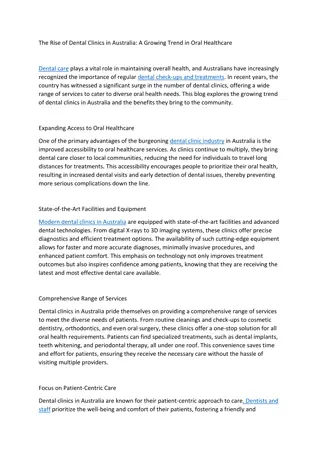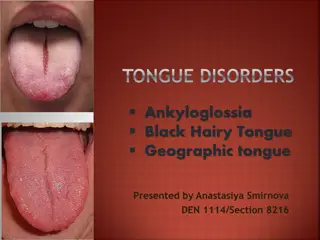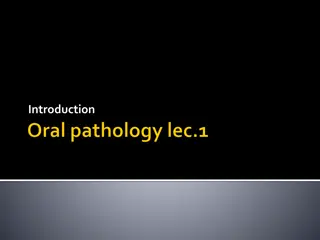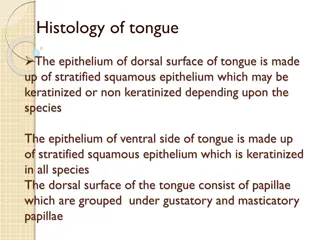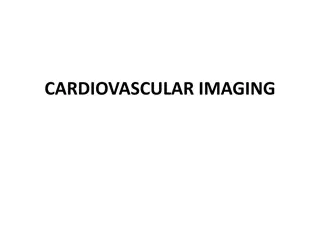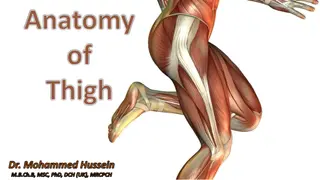Anatomy of the Tongue: A Detailed Exploration
Squamous epithelium, striated muscle, and various types of papillae make up the intricate structure of the tongue. Filliform, fungiform, circumvallate, and foliate papillae play different roles in sensory perception and taste. Taste buds, Van Ebner's glands, and gustatory furrows add complexity to the tongue's anatomy, reflecting its crucial functions in speech, taste, and oral health.
Download Presentation

Please find below an Image/Link to download the presentation.
The content on the website is provided AS IS for your information and personal use only. It may not be sold, licensed, or shared on other websites without obtaining consent from the author.If you encounter any issues during the download, it is possible that the publisher has removed the file from their server.
You are allowed to download the files provided on this website for personal or commercial use, subject to the condition that they are used lawfully. All files are the property of their respective owners.
The content on the website is provided AS IS for your information and personal use only. It may not be sold, licensed, or shared on other websites without obtaining consent from the author.
E N D
Presentation Transcript
Dr. SANJAY KUMAR BHARTI HEAD,VETERINARY ANATOMY
This squamous epithelium and striated muscle, arranged in a number of layers. The connective tissue attaches the tough mucous membrane of the tongue to the muscular mass. The epithelium of the tongue is thickest and has the heaviest stratum corneum on the dorsal surface. The tongue bears various papillae, which are named for their characteristic gross morphology. The papillae are macroscopic projections formed with a central core of connective tissue and a covering layer of stratified squamous epithelium. The tissue core may give rise to small microscopic papillae (commonly referred to as papillary bodies) over which the epithelium is moulded. According to the shape, the (macroscopic) papillae of the tongue are divided into various types. Filliform, Fungiform, Cirucumvallate (present in all animals) and Foliate (present in horse, donkey, ). organ consists essentially of a lining of stratified
Filliform papillae The filliform papillae consist of a connective tissue core derived from the lamina propria and an epithelial covering characterized by a heavy stratum corneum. The papillae are usually slender and pointed. In most species the papillary core does not extend above the level of the glossal epithelium. The visible projection is made up entirely of epithelium. Large conical papillae, whose core projects beyond the surface of the tongue, occur in all domestic mammals except the horse and donkey. Fungiform papillae These are relatively few in number and interspersed among the filiform palpillae. They have rounder and broader summits and narrow attached ends. The connective tissue core is rich in nerves and characterized by papillary body, have relatively less cornified epithelium containing taste buds. Taste buds may or may not be present.
Circumvallate papillae These are very few in number and are arranged in V shaped row nearer the posterior part of the tongue. They resemble fungiform papillae but are much larger and are surrounded by a cleft (moat) lined with epithelium. They project above the lingual epithelium only slightly or not at all. Their connective tissue core bears microscopic papillae and is rich in nerves and lymphocytes. The epithelial surface facing the moat contains many taste buds. Deeper to that papillae lie groups of serous glands called Van Ebner s glands whose excretory ducts open into the moat at various levels. Foliate papillae These are present only in some animals and each consists of a series of parallel connective tissue leaves, rich in nerves and bearing secondary papillae that project into the covering stratified squamous epithelium. Gustatory furrows separate them from each other. The epithelium covering the sides of the leaves bears taste buds. Deeper to the papillae lie serous glands whose ducts empty into the gustatory furrows.
These are microscopic structures found in the epithelium of the fungiform, foliate and circumvallate papillae of the tongue; they are also found widely separated in the soft palate; epiglottis and the free edge of the vocal folds. They are ellipsoid bodies embedded in an upright position in the epithelium of the mucous membrane. The taste bud is made up of supporting or sustentacular cells and neuroepithelial cells. The peripheral supporting cells form the outer layer of the taste bud. These are curved narrow cells with an ellipsoid nucleus, which surrounds the central supporting cells which are shorter and straighter than the peripheral ones and rounded off on the distal end. In some species the taste buds also contain basal supporting cells. These lie deep to the other supporting cells and are connected to them by means of processes.
The neuroepithelial cells lie among the supporting cells. These are slender cells thickened slightly in the region of the nucleus and resemble the central supporting cells. Each is characterized externally by a fine hair-like process called taste hair which projects the epithelium called the taste pore. The inner end of the cells tapers to a fine process, which may be single or branched. The sensory nerve fibre which convey gustatory impulses end within the taste buds in a network of varicose fibres called intragemmal fibres. The terminations of the intragemmal fibres end directly on the cells. Some of the termination also end between the cells (inter gemmal fibres). Dissolved substances stimulate the sensory cells. The lingual glands are situated partly below the mucous membrane, partly in the inter-muscular tissue, and are especially abundant on the root, on the margins and near the circumvallate papillae. Those in the region of circumvallate papillae are the serous glands of Van Ebner. The remaining glands are all mucous glands. through a minute opening in
The wall of oesophagus consists of a mucous membrane lined by stratified squamous epithelium and a muscular coat, which in the cervical region is covered by a loose fibrous adventitia. In the thoracic region, the latter is replaced by a serous membrane.
Mucosa It is lined by stratified squamous epithelium and is thrown into longitudinal folds. The lamina propria is made up of closely woven collagenous fibres with some elastic fibres interspersed in it. Its well-developed papillary superficially cornified, stratified squamous epithelium. The musclaris mucosae is made up of longitudinal smooth muscle fibres, which may few muscle fibres, only in the initial part in some species. Mucosa body is overlaid by consist of a part of
Submucosa It is composed of loose network of coarse collagenous fibres, which permit formation of longitudinal folds. Mucous glands occur in the submucosa and they are made up of typical mucous alveoli with short ducts, which pass through the submucosa and muscularis mucosae and open between the two adjacent connective tissue papillae. The initial portions of cuboidal epithelium but stratified epithelium in development of the submucosal glands varies in different parts of the oesophagus and also in different species. the duct this lamina are lined by change propria. to a the The
Tunica muscularis It is made up of striated muscle with some smooth muscle at the caudal end. It consists of two layers, which course spirally at the beginning and become distinctly an inner and outer longitudinal layer gradually. Tunica fibrosa This is composed of loose connective tissue which binds the oesophagus to the surrounding structures in the cervical region. In the thoracic region there is serosa, covering the muscular coat.
The wall of the stomach consists of a mucosa, submucosa, muscularis and serosa tunics. The true gastric mucosa is characterized by the presence of gastric glands. Only the stomach of man and carnivores are lined by gastric mucosa exclusively. In solipeds and swine the the stomach bears a cutaneous squamous epithelium). Ruminants have a stomach consisting of four compartments, three nonglandular diverticula fore stomach and a true glandular stomach. oesophageal portion (stratified of mucosa comprising the
The forestomach consists of four compartments, Rumen, Reticulum, Omasum and Abomasum The wall of the fore stomach consists of a non-glandular mucous membrane, a two-layered muscular tunic, and a serosa.
Rumen The mucosa forms large tongue shaped or conical papillae. The mucosa has neither gland nor lymph nodules. The stratified squamous epithelium is of the cornifying type and the stratum corneum forms relatively thick layer on the summits of the papillae. The stratum granulosum and stratum lucidum are more or less continuous. Cells of the of stratum lucidum often swells up to become nucleated vesicles, with a cornified wall and non-stailnable cytoplasm.
The lamina propria consists of a dense filtered of fine collagenous and many elastic fibres. Muscularis mucosa is absent. Submucosa is loose and blends with the lamina propria without any line of demarcation. Tunica muscularis has two layers an outer longitudinal and inner circular (of plain muscle). The serosa bridges the ruminal grooves, where the subserous connective tissue is thick with fat, nerves and blood vessels.
Reticulum Macroscopically the mucous membrane forms permanent folds enclosing 4 or 6 sided spaces or cells. Smaller folds subdivide the cells. These folds bear microscopic papillae on their sides. The folds and the papillae have a central core of connective tissue and are lined by stratified squamous cornified type of epithelium. A dense layer of stratum corneum covers the tip of the papillae and the folds. In very large fold a band of smooth muscle fibres occurs running in the same direction as the fold itself. Muscularis mucosae are otherwise absent. The two layers of muscular tunic (of plain muscle) follow an oblique course and cross at right angles. A tunica serosa is present.
Omasum The mucosa forms numerous folds or Omasal laminae of different sizes. These folds or laminae are studded with numerous papillae. Each lamina includes the entire mucosa, muscularis mucosae and submucosa. The mucous membrane squamous epithelium and dense capillary nets are found under the epithelium. The muscularis mucosae are distinct and extend into the folds and may occasionally send fibres into the papillae on the laminae. The larger folds are composed of tissue, which resembles mucous connective tissue. The muscular coat consists of two layers of plain muscle an outer thin longitudinal layer and inner thick circular layer. Omasum is lined by stratified
Omasum From the inner layer, bundles extend into the folds so that the large folds show on section, epithelium on both sides deeper to which lies the muscularis mucosae on each side. A thin stratum of submucosa separate the muscularis mucosae on each side form the central band of muscular layer derived form the inner circular layer of muscularis. At the free edge of the of muscle fibres fuses with the marginal thickening of muscularis mucosae. Aserosa is present. folds the central layer
STOMACH The wall of the stomach is composed of a mucosa, submucosa, muscularis and serosa. Tunica mucosa consists of Surface epithelium, The glandular lamina propria, Muscularis mucosae. Mucosa Surface epithelium It begins abruptly at the squamous epithelium of the oesophageal mucosa. It consists of a single layer of high columnar cells. The oval nucleus lies in the basal part of the cell. No distinct striated border can be seen with light microscope. The surface epithelium is continued into depression in the gastric mucosa - the gastric pits, bottom of which show shorter and broader cells. The glands open into the bottoms of gastric pits, which correspond to ducts. jagged border of stratified
STOMACH Lamina propria Contains gastric glands supported by delicate connective tissue framework. The connective tissue contains fibroblasts and histiocytes and there is diffuse infiltration with lymphocytes. There is less connective tissue between the glands than between the pits. The gastric glands are simple branched tubular glands. Several of them open into one gastric pit. These glands are of three types: fundic, pyloric and cardiac glands
STOMACH Fundic They are distributed through the greater part of gastric mucosa. Each gland consists of a body or main part, which ends below in a blind and dilated extremity (the fundus) and is continued upwards into a constricted portion, the neck, which opens into the bottom of a gastric pit. The body of the gland contains two kinds of cells- Chief and parietal. Chief cells These are cuboidal or pyramidal and contain coarse secretory (zymogen) granules. In H and E preparations the cytoplasm of chief cells stain blue. Nuclei are spheroid and are at the basal end, Chief cells secrete pepsin. Fundic glands glands
STOMACH Fundic Gland- Parietal cells These are larger than chief cells, and are oval or polygonal; the finely granular cytoplasm stains deeply with acid dyes (eosin). Nucleus is spherical and centrally located in the cell. These cells lie outside the Chief cells or between them. They maintain connection with the lumen by intercellular canaliculi, which extend between the chief cells. Intracellular canaliculi are also present. The parietal cells/ oxyntic cells secrete hydrochloric acid. The neck of the gland is made up of mucous cells, which may be interspersed among parietal cells. They are cuboidal with oval nuclei situated at the base of the cell. The cytoplasm stains light blue in ordinary preparations. These cells secrete mucous, it is believed that the mucous secreted by these cells contains theintrinsic factor, which enhances the absorption of extrinsic factor (Vitamin B12) necessary for haemopoiesis.
STOMACH FUNDIC GLAND- Argentaffin cells or (Chromaffin cells) These cells show fine cytoplasmic granules, staining black by silver impregnation technique may occur as isolated cells between the basement membrane and chief cells. They are said to contain, serotonin, a vasoconstrictor substance, contraction of plain muscle which stimulates the
STOMACH Pyloric glands These are coiled tubular glands. In sections mostly transverse and oblique sections of the tubule are seen. The ducts of the glands are longer but the body is shorter and the cells of the body resemble mucous cells. The glands secrete mainly mucous. Between the cells of the gland, narrow eosinophilic Stohr s cells are often found. The gastric pits or ducts are longer (or deeper) and are lined by eosinophilic columnar cells.
STOMACH Cardiac glands They between esophagus and stomach in simple stomached animals. In horse, it is restricted to the narrow zone close to the Margoplicatus cardiac glands are located close to the omaso-abomasal junction. These are highly tubular glands. The ducts are very long i.e., the pits are very deep. The body has a relatively wide lumen and lined by clear pyramidal or cubodial cells with a basally located nucleus. They secrete mucous and these glands pass over gradual transition into typical gastric glands. occur at the transition zone, junction. In ruminants, branched and coiled,
STOMACH Muscularis mucosae Plain muscle fibres interwoven or stratified forming a thin layer fibres extend into the lamina propria. Submucosa This is made up loose connective tissue. Tunica Serosa The serous coat consists of a layer of loose connective tissue which is covered by mesothelium.
Species differences The anterior oesophageal region of the stomach in horse is lined by a cornified stratified squamous epithelium. Behind this there is fundic gland area and then pyloric gland area. Between the oesophageal region and fundic area, there is a narrow cardiac area. The abomasum of ruminant consists of cardiac, fundic and posterior pyloric gland areas. In the carnivores there is a fundic and pyloric area. Near the cardia there is a narrow zone of cardiac gland area. A lamina subglandularis intervenes mucosae and the blind ends of the glands. In old animals, it becomes stratified into an inner stratum granulosum rich in cells and an outer stratum compactum consisting of network of dense, hyaline collagenous substance. between muscularis
The small intestine is divisible into three portions, - duodenum, jejunum and ileum, which gradually pass into one another. Their general structure is similar although each division has certain distinctive features. The intestinal a mucosa, submucosa, muscularis and a serosa. Tunica mucosa This may be divided into the following layers: Epithelium Lamina propria, which has glands and in the small intestines forms villi; Muscularis mucosae wall consists of
Epithelium Surface epithelium is simple columnar with goblet cells distributed among the columnar cells. Columnar cells are narrow and high and reach their greatest height on the villi. Nucleus is oval and is situated in the lower half of the cell. The cytoplasm is finely granular and usually acidophilic. These cells shown striated free border, which appear under light microscope as fine striations in the cytoplasm. EM studies revealed that the striated free border is actually made up of fine closely packed cytoplasmic filaments or processes, which are now referred to as microvilli.The microvilli are considered as an adaptation of cell surface for better absorption of digested food material from the intestine.
Epithelium .Scattered among the columnar cells are mucous secreting goblet cells. They vary in appearance according to the amount of secretion they contain. The cell at the beginning contains a small amount of mucin near its apical border. As secretion increases the mucous gradually displaces the cytoplasm and the nucleus is flattened pushed the nucleus towards the base of the cell. The distended cell has the appearance of goblet and the cytoplasm stains faintly basophilic or not at all but can be stained intensely by special mucin stains. The secretion is discharged through the free surface (apocrine) and goblet cells go through cycles of secretory activity.
Lamina propria It has a supporting framework of reticular tissue with elastic fibres and delicate collagenous fibres. There is diffuse infiltration with numerous lymphocytes and in certain places isolated lymph nodules known as solitary glands may be found in the lamina propria. In the small intestine, projections of lamina propria covered by surface epithelium called villi occur throughout. Both in small and large intestines, the lamina propria contains simple tubular glands, called crypts of lieberkuhn or intestinal glands.
Intestinal Villi These structures serve to increase the intestinal surface area available for absorption. They are narrow and elongated projections, measuring on the average of 0.5- 1mm in length and 0.2 mm in width. In the center of each villus occur a tubular lymph space known as a lacteal and is lined by endothelium. The reticular spongy stroma of villi contains leucocytes, fat droplets, capillaries, elastic fibres and bundles of smooth muscle fibres. These muscle fibres originate from muscularis mucosae.
Intestinal glands or Crypts of Lieberkuhn These are simple tubular glands found in the lamina propria. They open between the villi and extend to the lamina propria as far as the muscularis mucosae. They are surrounded by reticular fibres and consist of glandular epithelium resting The epithelium is made-up of columnar cells as the surface epithelium with which it is continuous but the cells of gland are shorter and their striated border becomes less distinct until they finally disappear, in the deeper portions of the gland. Goblet cells are more abundant in the deeper portions than in the surface epithelium. In the small intestine the gland fundus contains the specialized granular cells of Paneth. These are serozymogenic having the characteristic striated chromophilic material in the basal region and large refractile acidophilic granules apically. They show activity during digestion. It is believed that these cells may be producing some digestive enzymes but the exact functional significance is not known. on a thin basement membrane.
Enterochromaffin or argentaffin cells also occur among the crypts of the intestinal glands. They occur usually singly and contain specific granules in the basal part of the cell, which are stained by silver and chromium salts. They contain serotonin but their exact functional significance is not known. Muscularis mucosae: consist of smooth muscle fibres, which are in two layers perpendicular to one another. They may interweave. Submucosa Consists of loose connective tissue and elastic fibre nets. In contains large blood vessels, lymphatics and nerve plexus in the submucosa. Tunica muscularis This is well developed, made up of plain muscle fibres and consists of thinner outer longitudinal layer and thicker inner circular layer. The two layers are connected by inter-muscular connective tissue.
small intestine Duodenal thin. In the epithelium, columnar cells preponderate over goblet cells. Submucosa found as Brunner Duodenal Mucosa Mucosa: : The villi are broad spatula spatula shaped and Submucosa - Branched tubuloalveolar glands are in Brunner glands the or Duodenal connective glands. tissue known glands or Duodenal glands These glands are lined by low columnar cells, which resemble pyloric gland. The nucleus is flattened and is located at the base of the cell and the cytoplasm is faintly basophilic glands secrete mucous and the ducts, which are lined by columnar cells, open between the villi or into the crypt Lieberkuhn basophilic. These crypt of of Lieberkuhn
The large Intestine consists of caecum, colon and rectum and the general structure of these parts are similar. The structure of large intestine resembles that of the small intestine except for the following differences. Mucosa There are no villi. Intestinal glands or crypts of Lieberkuhn are present throughout and they are longer and straighter. The surface epithelium consists of tall columnar cells but the Goblet cells far exceed in number than the columnar cells. The crypts of Lieberkuhn also contain numerous goblet cells and towards the distal portions of the intestine the crypts appear to be lined entirely by goblet cells. The mucous membrane of the rectum is usually thrown into a number of longitudinal folds. At the anus, the simple columnar epithelium is replaced by stratified squamous epithelium, which becomes continuous with the epidermis beyond the anal orifice. The submucosa and muscularis do not present any special features. The serous coat is absent in the terminal portion of the rectum and is replaced by a fibrous coat.
Species difference The large intestine of man, solipeds and pigs, possess flat bands of longitudinal muscle known as taeniae. (For details about the number and extent of these bands in the horse, refer splanchnology). In the dog and pig at recto-anal anal glands are present. In pigs, it produces a mucous secretion and in dogs it produces a fatty secretion. In the dog, circumanal glands occur at the site where anal mucosa becomes continuous with the skin. These consists of a sebaceous portion, which opens through a patent duct into an adjacent hair-follicle and a non-sebaceous portion, which exhibits no evidence of any secretory activity. Lateral and ventral to the anus in carnivores are the anal sacs. The wall of anal sac is covered by stratified squamous epithelium. In the loose subepithelial layer are apocrine tubularglands in the dog and in the cat, sebaceous glands are present in addition. The excretory ducts of anal sacs also contain tubular and sebaceous glands. junction, tubulo-alveolar
Trachea is thin walled, rigid tube continuing with larynx and terminates in two chief bronchi. The following layers are recognized: Mucosa Submucosa Alayer of fibroelastic membrane with hyaline cartilage rings and Adventitia Mucosa It is lined by pseudostratified ciliated columnar epithelium with numerous Goblet cells between the ciliated columnar cells. The basement membrane is distinct. The lamina propria contains numerous elastic fibres and a fibro-elastic membrane may be formed in the deeper zone, separating the lamina propria form the submusosa.
Submucosa It consists of loose connective tissue and contains, mixed or mucous glands. The framework of trachea consists of series of regularly arranged C-shaped rings of hyaline cartilage. The open segment of C is dorsal and between the free cartilage, smooth muscle bundles (trachealis) are present. Most of the muscle fibres are arranged transversely. A fibroelastic membrane, which blends with the perichondrium extends between the adjacent cartilages and also between the open ends of the cartilaginous rings enclosing the smooth muscle bundles. This fibro elastic membrane is called the tracheal annular ligament. The adventitia has collagenous and elastic tissue with adipose tissue and contains blood vessels and nerves. Species differences In the horse, ruminant and pig, the smooth muscle fibres lie inside the ends of rings of cartilage, but in the dog and cat they lie outside the ring. In man, it connects the two ends
Bronchi Mucosa: Pseudostratified columnar ciliated epithelium with numerous goblet cells. In submucosa mucous glands are present. Plain muscle lies inner to cartilage plates and forms a continuous cuticular layer (unlike in the trachea). Hyaline cartilage occurs only in the form of isolated plates. Bronchioles (small unit) Mucosa simple columnar ciliated epithelium with Goblet cells. submucosa. Smooth muscle layer. Cartilageplates are absent. Terminal Bronchioles: The columnar ciliated epithelium. No goblet cells are present and no glands occur below the mucosa. A relatively thicker smooth muscle is present, in the wall but cartilage is absent. The terminal bronchiole divides into two or more respiratory bronchioles. No glands a occur in cirular the forms continuous mucosa is lined by simple
The lungs are paired organs located in the thoracic cavity. The surface of each lung is covered by a serous membrane (pleura). Each lung is divided into a number of lobes and pleura, dips into interlobar fissures tissue and covers interlobar surfaces. Each lobe is sub-divided by interlobular tissue into lobules. Each lobule is pyramidal with apex towards the hilus and base towards serous membrane Lobulations are visible as polygonal areas on the surface of lungs. The lobulation is not so distinct in many animals, because there is less of interlobular connective tissue. The septa of interstitial tissue contain, bronchi, vessels and nerves. Each lobule contains the respiratory structures arising from a terminal bronchiole.
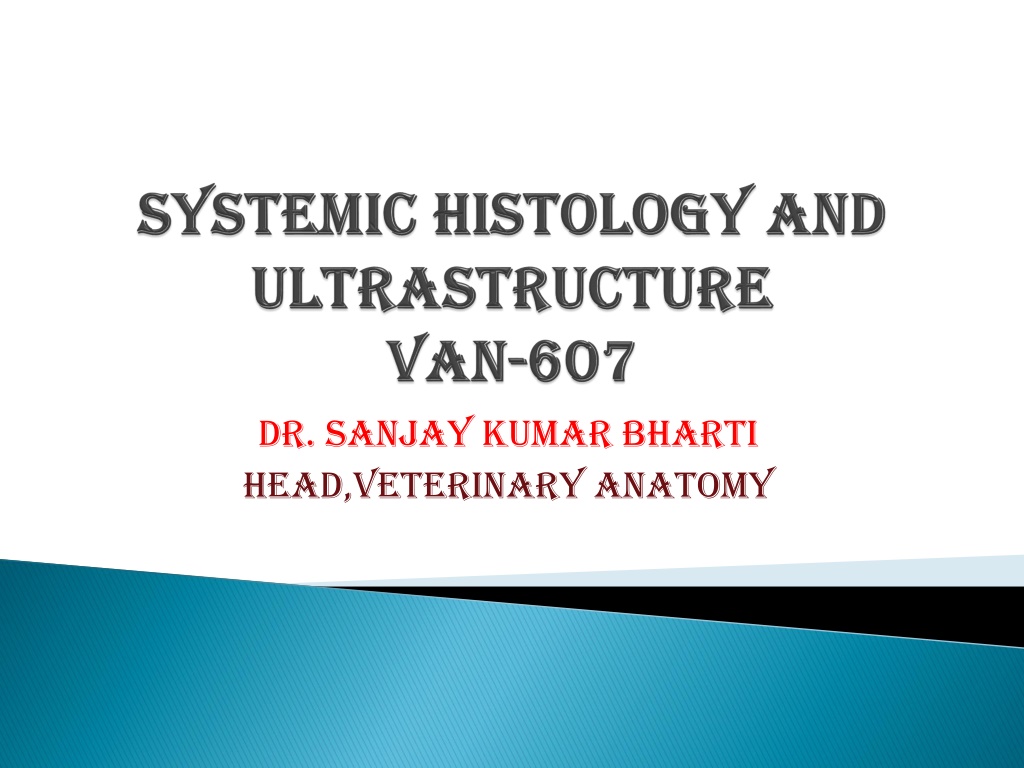
 undefined
undefined



